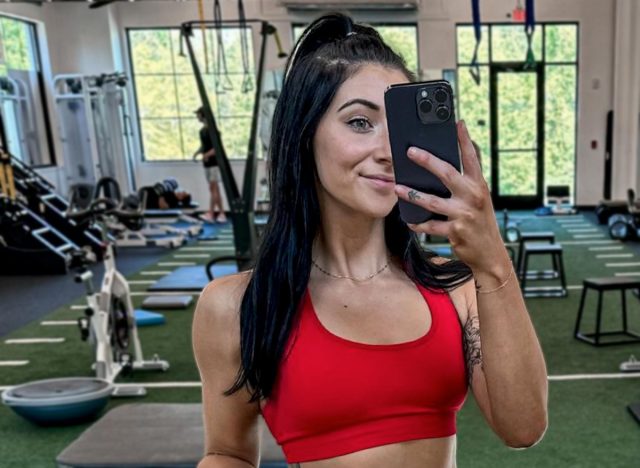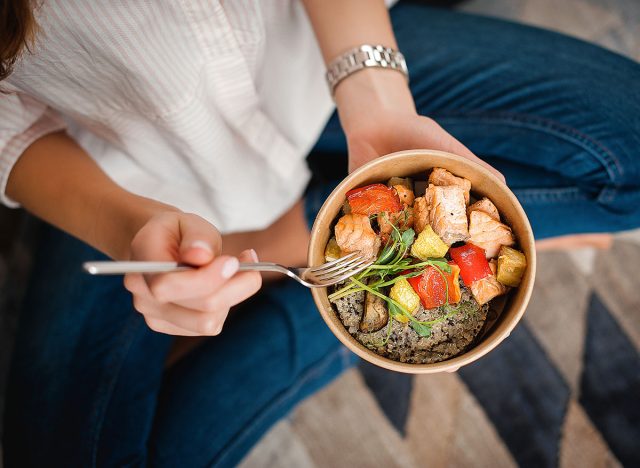3 Things That Helped Me Break the Cycle of Yo-Yo Dieting
Are you struggling to break the pattern of yo-yo dieting? Fitness influencer and online coach Jenna Rizzo helps women get in shape in a natural way – via diet and exercise. In one of her posts, she discusses the push-and-pull of dieting and how to break it. "If you are sick of yo-yo dieting and gaining and losing the same 10 to 20 pounds, listen up. My name's Jen. I've been a fitness coach for the past six years, and I specialize in women's weight loss," she says in the clip. Body Network's Resident RDN, The Diet Diva, Tara Collingwood, MS, RDN, CSSD, LD/N, ACSM-CPT, a Board Certified Sports Dietitian and co-author of the Flat Belly Cookbook for Dummies, weighs in on what she has to say.
Rizzo Would Diet Monday Through Friday and Indulge on the Weekends

"Back when I first started my fitness journey, I fell into a really bad cycle of yo-yo dieting," Rizzo confesses. "I would restrict myself so much during the week and lose a bunch of weight Monday through Friday, but weekends were like my Achilles heel, like I would go crazy and eat everything. Here are the three things that help me break the cycle once and for all."
She Let Go of Perfection

"Number one, I let go of trying to be perfect on my diet throughout the week," she explains. "When I say I tracked everything, I mean it, every gram, every ounce, every milliliter, everything was accounted for. I had it in my brain that I was either a hundred percent perfect or a hundred percent off the rail and there was no in between. So letting go of that mentality is truly what helped me find balance. And I do still track now if I'm just trying to tighten up, but it's much more laid back. I'm just tracking to make sure I'm eating enough and actually getting enough protein in."
Related: This Is Exactly How to Lose Body Fat This Year
She Loosened Her Food Rules

"Number two, I slowly let go of these food rules that I'd set for myself, like eating super low calorie on a day," she says, adding that she stopped telling herself "that some foods are good and some foods are cheating foods." Once she let go of the rules, "food just became food again," she said. "Like I eat healthy now because it makes me feel good, not because I have some anxiety about getting out of shape."
She Allowed Herself to What She Wanted, When She Wanted It

This led her to number three. "I allowed myself to eat the foods I wanted, and no doubt this was the hardest one to control in the beginning," she said. "But once I started to allow myself to just eat kind of whatever I wanted when it sounded good to me, it allowed food to not be such a big deal anymore. So it wasn't something I felt like I needed to binge on because I couldn't have it again, if that makes sense."
RELATED: 5 Exercises Wrecking Your Bone Health After Menopause
Body Network's Expert Weighs In

Being too regimented and "weighing and measuring every morsel of food you eat definitely takes the fun out of eating and creates an atmosphere of guilt when you have a minor little slip," agrees Collingwood. However, tracking for a while is "great for awareness of how many calories are in foods and approximately how many you are getting in a day, but getting too strict has it's downfalls and can create an eating disorder mindset," she says.
As for food rules, having the mindset of balance is key to fueling yourself well, she says. "Your attitude on food can go a long way to a peaceful mind. If you are constantly attaching guilt or praise to certain foods you are putting too much emotion into foods and that can then affect your mental and emotional state in other areas of your life. Looking at food as nourishing and positive for health instead of evil for weight gain is a huge step for a lot of chronic dieters," she explains. And, too strict rules lead to rules being broken "and sometimes going way overboard the other way," she says.
"I have seen people undo 6 days of really strict eating in just one 'cheat' meal because they eat way too much in that meal. Allowing yourself to have all kinds of foods in moderation rather than binging helps to maintain normalized eating and a feeling of peace around food."
💪🔥Body Booster: If you are struggling with binge eating or yo-yo dieting, try and reset your relationship with food.
@jennaaaamariee3 first steps i took to help me put an end to my yo yo dieting♬ original sound – Jenna Rizzo | Weight Loss





